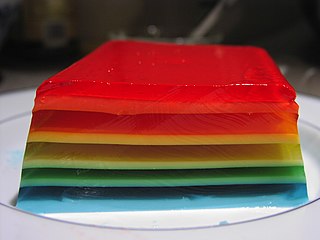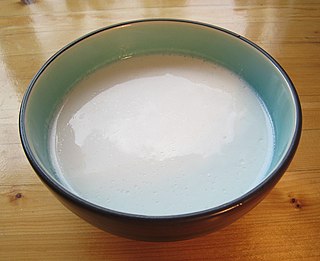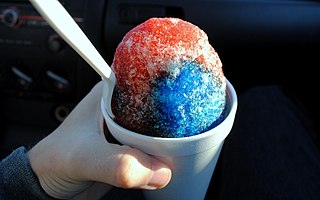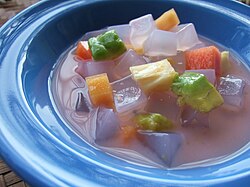
Gelatin desserts are desserts made with a sweetened and flavoured processed collagen product (gelatin). This kind of dessert was first recorded as jelly by Hannah Glasse in her 18th-century book The Art of Cookery, appearing in a layer of trifle. Jelly is also featured in the best selling cookbooks of English food writers Eliza Acton and Isabella Beeton in the 19th century.

Coconut milk is an opaque, milky-white liquid extracted from the grated pulp of mature coconuts. The opacity and rich taste of coconut milk are due to its high oil content, most of which is saturated fat. Coconut milk is a traditional food ingredient used in Southeast Asia, Oceania, South Asia, and East Africa. It is also used for cooking in the Caribbean, tropical Latin America, and West Africa, where coconuts were introduced during the colonial era.

Filipino cuisine is composed of the cuisines of more than a hundred distinct ethnolinguistic groups found throughout the Philippine archipelago. A majority of mainstream Filipino dishes that compose Filipino cuisine are from the food traditions of various ethnolinguistic groups and tribes of the archipelago, including the Ilocano, Pangasinan, Kapampangan, Tagalog, Bicolano, Visayan, Chavacano, and Maranao ethnolinguistic groups. The dishes associated with these groups evolved over the centuries from a largely indigenous base shared with maritime Southeast Asia with varied influences from Chinese, Spanish, and American cuisines, in line with the major waves of influence that had enriched the cultures of the archipelago, and adapted using indigenous ingredients to meet local preferences.

Halo-halo, also spelled haluhalo, Tagalog for "mixed", is a popular cold dessert in the Philippines made up of crushed ice, evaporated milk or coconut milk, and various ingredients including side dishes such as ube jam, sweetened kidney beans or garbanzo beans, coconut strips, [[]], [[]] (agar), pinipig, boiled taro or soft yams in cubes, flan, slices or portions of fruit preserves and other root crop preserves. The dessert is topped with a scoop of ube ice cream. It is usually prepared in a tall clear glass and served with a long spoon. Halo-halo is considered to be the unofficial national dessert of the Philippines.

Piña is a traditional Philippine fiber made from the leaves of the pineapple plant. Pineapples are indigenous to South America but have been widely cultivated in the Philippines since the 17th century, and used for weaving lustrous lace-like luxury textiles known as nipis fabric. The name is derived from Spanish piña, meaning "pineapple".

Shaved ice is a large family of ice-based desserts made of fine shavings of ice and sweet condiments or syrups. Usually, the syrup is added after the ice has been frozen and shaved—typically at the point of sale; however, flavoring can also be added before freezing. The dessert is consumed worldwide in various forms and ways. Shaved ice can also be mixed with large quantities of liquid to produce shaved ice drinks.

Buko pie, sometimes anglicized as coconut pie, is a traditional Filipino baked young coconut (malauhog) pie. It is considered a specialty in the city of Los Baños, Laguna located on the island of Luzon.

Bicol express, known natively in Bikol as sinilihan, is a popular Filipino dish which was popularized in the district of Malate, Manila but made in traditional Bicolano style. It is a stew made from long chili peppers or small chili peppers, coconut milk/coconut cream, shrimp paste or stockfish, onion, pork, ginger and garlic. The dish was termed by Laguna resident, Cely Kalaw, during a cooking competition in the 1970s in Malate, Manila. The name of the dish was inspired by the Bicol Express railway train that operated from Tutuban, Manila to Legazpi, Albay. The widely-known name for this dish in the Bicol Region of the Philippines was identified as gulay na may lada, which is currently one of the vegetarian variants of the Bicol express dish. As time progressed, variants of the Bicol express dish expanded with seafood, beef, pescatarian, vegetarian, vegan, and other versions. The preparations for these dishes vary according to the meat present within the dish. In terms of nutritional value, the original version of the Bicol express dish is beneficial in protein but unhealthy in regards to its high levels of saturated fats and cholesterol. The dish has moved into food processing and commercial production so that it can be sold conveniently and stored for a longer period of time.
Lambanóg is a traditional Filipino distilled palm liquor. It is commonly derived from tubâ made from coconut sap that has been aged for at least 48 hours. It originates from Luzon and the Visayas Islands. During the Spanish colonial period, it was also known as vino de coco in Spanish. It is also commonly described as "coconut vodka" due to its clear to milky white color and high alcohol content. It is particularly potent, having a typical alcohol content of 80 to 90 proof after a single distillation; this may go as high as 166 proof after the second distillation.

Macapuno or coconut sport is a naturally occurring coconut cultivar which has an abnormal development of the endosperm. The result of this abnormal development is a soft translucent jelly-like flesh that fills almost the entire central cavity of coconut seeds, with little to no coconut water.

Bua loi or bua loy is a Thai dessert. It consists of rice flour rolled into small balls, and cooked in coconut milk and sugar. Some Bua loi also adds sweet egg into the recipe. It was inspired by Tangyuan, a Chinese dessert that is traditionally eaten around the Lantern festival. Bua Loi also traditionally eats at the Dongzhi Festival in Thailand, which is festival for the Chinese-Thai bloodline. There are a variety of versions of Bua loi such as using food coloring instead of natural color, using soy milk instead of Coconut cream, sliced Pumpkin to add inside rice balls, et cetera. There's other type of Bua loi in other country from China, Japan, Indonesia, Myanmar, Philippines, Southern Vietnam and Malaysia. 1 cup of Bua Loy has total calories of 295.5 kilocalories, protein of 10.4 grams, carbohydrate of 6.3 grams, and fat of 25 grams.
Komagataeibacter xylinus is a species of bacteria best known for its ability to produce cellulose, specifically bacterial cellulose.

Buko salad, usually anglicized as young coconut salad, is a Filipino fruit salad dessert made from strips of fresh young coconut (buko) with sweetened milk or cream and various other ingredients. It is one of the most popular and ubiquitous Filipino desserts served during celebrations and fiestas.

Ube ice cream is a Filipino ice cream flavor prepared using ube as the main ingredient. This ice cream is often used in making the dessert halo-halo.
Nata de piña, also marketed as pineapple gel or pineapple gelatin, is a chewy, translucent, jelly-like food produced by the fermentation of pineapple juice. It is a traditional dessert in the Philippines, produced since the 18th century using waste pineapple juices from the piña fiber industry in Pagsanjan, Laguna. It has a sweet-sour taste and is popularly used in fruit salads, jams, ice creams, candies, and various other dishes.

Knickerbocker is an ice cream sundae dessert from Zamboanga City, Philippines made up of various fresh fruit chunks, flavored gulaman (agar) cubes, and nata de coco in condensed milk topped with strawberry ice cream. The fruits used include mangoes, bananas, dragonfruit, papaya, honeydew melon, apples, grapes, cherries, pineapple and watermelon, among others. Sometimes vanilla or chocolate ice cream may also be used. Nuts are also sometimes added. It has sometimes been regarded as a variant of halo-halo but differs in that the knickerbocker doesn't contain shaved ice. It is most similar to the American and British sundae dessert knickerbocker glory, from which it was derived from, but also differs in the ingredients. The dish was first popularized by the Hacienda de Palmeras restaurant before spreading throughout the city.
















